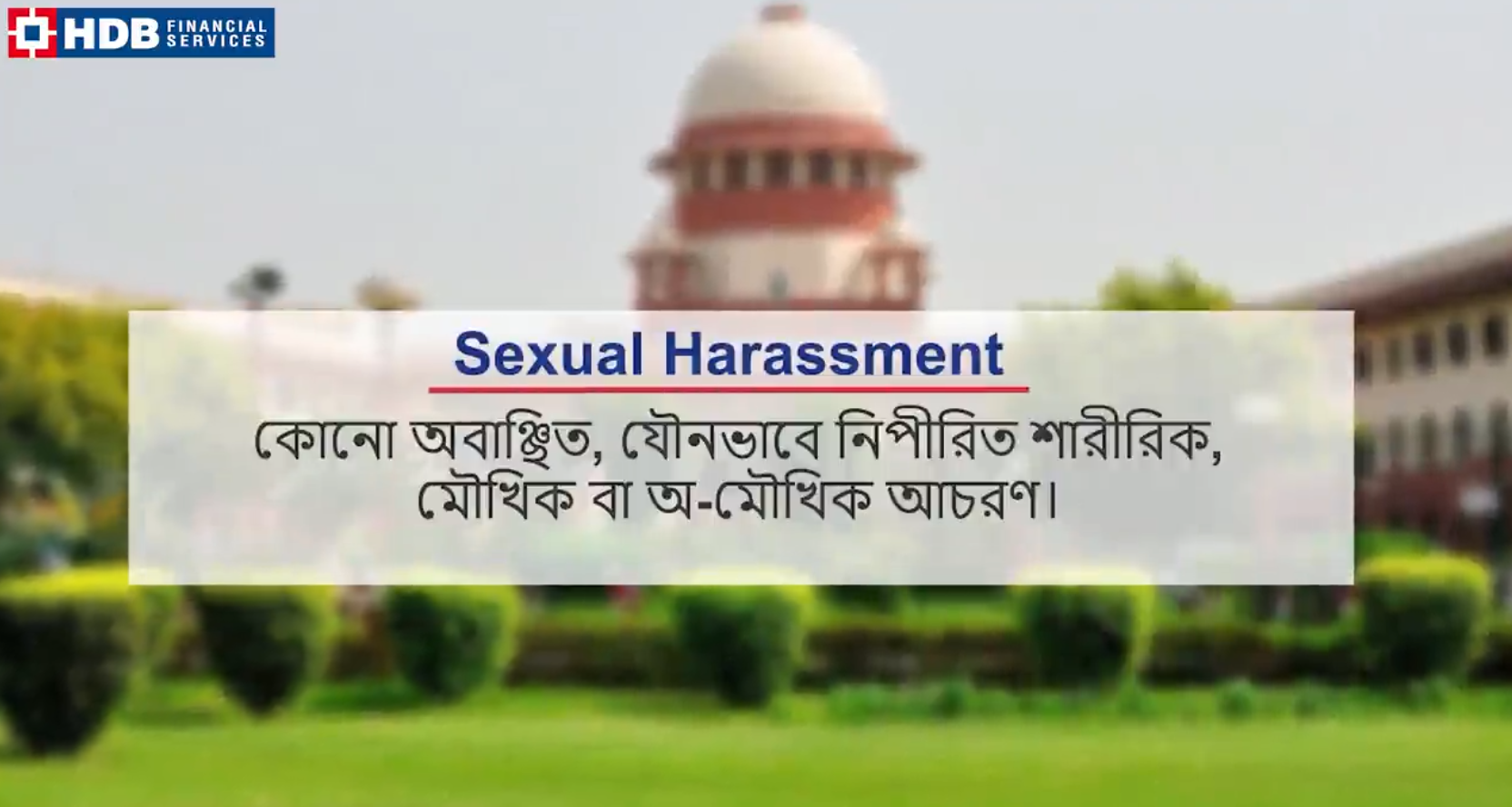HDB SCORM & Videos
Videos
POSH Script
The Sexual Harassment of Women at Workplace Act
(Prevention, Prohibition and Redressal)
The Sexual Harassment of Women at Workplace (Prevention, Prohibition and Redressal) Act, 2013
In alignment with the Vishaka judgement, the Government of India passed the Act to prevent sexual Harassment at workplaces to:
-
Ensure safe working spaces for women
-
Build enabling work environments that respect women’s right to equality of status and opportunity
According to the Act, any woman who wishes to report instances of sexual Harassment at the workplace has the right to take recourse of both civil and criminal proceedings.
The Act also mandates that…
-
Every employer must form an Internal Committee (IC) headed by a senior female employee.
-
To initiate an enquiry, an employee must file a complaint with IC within 3 months of the incident.
-
The IC must complete their inquiry within 90 days and submit case details and recommendations to the management.
The Internal Committee – it’s composition and inquiry process – is a topic that will be discussed at length in a the next module.
In the immediately succeeding lesson, though, we will understand what constitutes sexual harassment in the workplace.
Before proceeding to the next lesson, please take the accompanying quiz, a link to which is available right below this video.
Happy Quizzing!
What Constitutes Workplace Sexual Harassment?
The Supreme Court defined sexual harassment as any unwelcome, sexually determined physical, verbal or non-verbal conduct.
An action is considered unwelcome if a woman expresses her discomfort or does not consent to an act such as a physical touch, a lewd joke, or unwelcome glances of a sexual nature, among others.
We will explore specific examples of unwelcome actions in a subsequent lesson:
Who is an “aggrieved woman”?
The Act recognises every woman’s right to a safe and secure workplace environment, irrespective of her age and employment status.
Therefore, the Act protects every woman working in or visiting a workplace:
-
In the capacity of regular, temporary, ad-hoc, or daily wages basis
-
Directly or through an agent or a contractor
-
As a contract worker, probationer, trainee, apprentice, or called by any other such name
-
In a dwelling place or house
-
With or without the knowledge of the principal employer
-
For remuneration, voluntarily or otherwise, their terms of employment either express or implied

Sexual Harassment constitutes a gross violation of women’s right to equality and dignity and has its roots in a mistaken belief that some forms of misconduct are acceptable, even in the workplace.
We outlined what constitutes sexual harassment in the workplace in this lesson.
In subsequent lessons, we will explore various actions that constitute sexual harassment in the workplace.
Before proceeding to the next lesson, though, please take the accompanying quiz.
Happy Quizzing!
Watching, Sharing or Exposing Colleagues to Pornographic Material: Sexual Harassment Incidents – I
In the previous lesson, we explored what sexual harassment is and how it can play out in the workplace.
In this lesson, we look at an incident on watching, sharing or exposing colleagues to pornographic content at the workplace, that comes under the purview of sexual harassment.
Scene 2
He responds cockily.
Female Employee (in anger and disgust): Rajesh… what…. por… in the office?… How could you!
Male Manager (cockily. Pointing to his phone screen, which he has turned towards her): What? That’s the way you came into this world. You did not fall from the skies. (laughs)
Examining the Case
————————————————
Scene 2:
You don’t need me to say this, but surely you wouldn’t ever want to associate with a colleague like that, would you?
Viewing or sharing any material that is pornographic in nature, whether imagery or text, in the workplace and subjecting others to it constitutes sexual harassment.
That off-colour WhatsApp message, that lewd joke online, that erotic book or magazine – whether digital or print, pornographic imagery or videos, on a computer, phone or tablet, these have no place in a workplace.
Under no circumstances. There are no two ways about this – it’s not open for discussion.
This is a clear case of sexual harassment. Keep all pornographic material at bay. Always.
In the next lesson, we will look at an incident related to using sexually coloured remarks in the workplace.
Before proceeding to the next lesson, please take the accompanying quiz, a link to which is available right below this video.
Happy Quizzing!
Sexual Harassment Incidents – II
In the previous lesson, we observed an incident related to watching, sharing or exposing colleagues to pornographic content in the workplace.
In this lesson, we look at an incident related to usage of sexually coloured remarks in the workplace, and why such remarks must strictly be avoided in the workplace.
Female Employee (stands up, wraps her jacket around herself and says aloud):
Can we increase the temperature in here? It’s freezing!
A male employee sitting nearby (turns around in his seat, with a broad smile, seemingly pleased with himself laughing at his own little joke):
“Stick close to me instead, darling, you’ll soon feel hot.”
Examining the Case
No. Not funny, my friend! And not cool!
Lewd, uncalled for, or sexually suggestive comments have no room in a workplace.
To that, you may add compliments that can be sexual or suggestive in nature, like “you are hot” or “I love your smile”. Complimenting someone on their clothing is fine as long it is not coloured with any sexual innuendo. So, “that is a smart jacket you are wearing” is acceptable. “That dress makes you look hot/ sexy/ pretty” is not.
Complimenting people on their talents, abilities and achievements is most welcome. Complimenting people on their anatomy is not.
This employee’s conduct, as depicted in this incident constitutes sexual harassment.
Bottom line: Leave trash talk where it belongs; in the trash can.
In the next lesson, we will look at an incident related to demanding for sexual favours in the workplace.
Before proceeding to the next lesson, please take the accompanying quiz, a link to which is available right below this video.
Happy Quizzing!
Sexual Harassment Incidents – III
In the previous lesson, we observed an incident related to using sexually coloured remarks, and why such remarks must strictly be avoided in the workplace.
In this lesson, we look at an incident related to demanding for sexual favours in the workplace.
A male employee is leaving work at the end of the day. A female employee is seen working.
Most other desks are vacant.
The employee who is leaving, slings his bag over his shoulder, pushes his chair back and leaves.
The clock on the wall reads 9:40pm.
The manager (a more elderly man) walks in towards the female employee and seats himself besides her in a vacant chair.
The employee who is leaving
Bye, Reema. See you tomorrow.
Female Employee (looks up from her desk, smiles)
Bye… See ya.
Gets back to what she was working on her computer
Manager: Working late today?
Female Employee (reluctantly): “Uh…yes… got somethings to finish.”
Manager (casually): “So, you’re applying for the Manager’s post, huh?”
Female Employee (again, reluctantly): “Yes, that’s true.”
Manager (drops his voice, speaks through pursed lips): “I can make things happen for you; you know. Only, something you want, for, you know, something… I want….”
(Turns towards her and smiles knowingly. After three seconds, gets up and leaves)
The female employee (is seen shivering in fear. Camera zooms in to her face)
———————————————————————
Examining the Cases
————————————————
How could… what was that manager even thinking? This is blatant sexual harassment!
Using your power to blackmail or coerce a fellow employee for sexual favours is a terrible abuse of power and sexual harassment.
It takes a genuinely rotten character to even conceive of such an act.
Remember, never, ever, abuse your power to seek sexual favours in return for any work-related benefits.
Narrator: “What a creepy manager! I hope none of us has to encounter such a kind.”
And, if you are ever subject to such behaviour, please do not hesitate to it take up with the concerned authorities.
In the next lesson, we will look at an incident related to using unwelcome gestures in the workplace.
Before proceeding to the next lesson, please take the accompanying quiz, a link to which is available right below this video.
Happy Quizzing!
Sexual Harassment Incidents – IV
In the previous lesson, we observed a sexual harassment incident related to demands for sexual favours in the workplace.
In this lesson, we will look at an incident related to using unwelcome gestures, and why such gestures must strictly be avoided in the workplace.
As always, we’re going to start with a small scene.
Scene 6
A young male employee, quite apparently staring at a female employee across workstations.
She catches him staring twice. He is smiling at her (in a creepy sort of way).
The third time she reacts.
Female Employee (annoyed): “What is it?”
Male Employee (reaches for something in his bag, raises up and walks up to her desk.): “I’ve got this for you.”
Holds out a wrapped gift
Female Employee (disgustedly, and in a high-pitched tone): “Look, I’ve told you before, and I am telling you for the last time, I do not appreciate your gifts and quit staring at me all the time. It’s creeping me out!”
Examining the Case
Yes, you must look people in the eye when you are speaking with them.
But unwelcome gestures such as staring at a person incessantly, or staring at specific parts of their anatomy, that’s sexual harassment.
Similarly, receiving gifts from someone could leave them feeling uneasy. If someone has already mentioned that they do not like such behaviour, continuing with it would constitute sexual harassment.
Remember, we must maintain cordial relationships with our co-workers but must refrain from any gesture that is unwelcome or makes them uncomfortable.
So far, we’ve looked at behaviours that constitute Sexual Harassment.
In the next lesson, we will elaborate on the different types of sexual harassment in the workplace.
Before proceeding to the next lesson, please take the accompanying quiz, a link to which is available right below this video.
Happy Quizzing!
A Recap
Based on the incidents observed in the preceding lessons, in this lesson we recap the different types of sexual harassment related to those incidents, starting with…
To understand verbal sexual harassment, let us revisit the incident on sexually coloured remarks, where a male employee shifts his chair close to his female colleague and says, “Why don’t you stick closer to me, darling? You will feel hot way sooner”, forcing her to look away in irritation.
Another example of verbal sexual harassment can be found in our lesson on demanding sexual favours, where a male employee – who is in a position of power – demands for a sexual favour from a subordinate female employee, in return for a promotion at work.
The actions contained in the clips, as well as
-
Enquiries about a colleagues’ sex life
-
Referring to a colleague, especially a woman, as ‘doll’, ‘babe’, ‘honey’, etc.
-
Repeatedly asking a colleague – who has previously expressed disinterest – for sexual favours or dates
Constitute what we call Verbal Sexual Harassment.
Let us now look at…
To understand non-verbal sexual harassment, let us circle back to the incident on watching, sharing, or exposing colleagues to pornographic content, where a male employee was caught watching pornographic content on his mobile by a female colleague.
Another example of non-verbal sexual harassment can be found in our lesson on unwelcome gestures, where a male employee makes his female colleague uncomfortable by staring at her continuously and offering an unwelcome gift.
These actions, along with…
-
Making lewd sexual gestures using one’s hands or through body movements such as winking, blowing kisses, licking one’s lips suggestively or thrusting
-
Whistling
-
Stalking
are examples of non-verbal sexual harassment are….
Lastly, we will look at…
-
Physical Sexual Harassment
The incident in this video, where the male employee casually drapes his arm around a female colleague’s shoulder, making her squirm in discomfort, is an example of physical, sexual harassment.
Other examples of this type of harassment are…
-
Hugging, kissing, stroking, and inappropriately brushing up against a colleague.
-
Touching a colleague’s clothing, hair or body.
-
Inappropriate display of one’s body
In all the incidents mentioned in this lesson, the common theme is that of an employee either not realising or not caring about how some of their words or actions towards colleagues amounts to sexual harassment, which if reported, would lead to strict disciplinary action by the employer – perhaps even termination of employment.
In the next lesson, we explore what constitutes a ‘workplace’.
Before proceeding to the next lesson, please take the accompanying quiz.
Happy Quizzing!
What Constitutes a “Workplace”?
In the previous lesson, we saw what sexual harassment is and how it can play out in the workplace.
In this lesson, we will explore the meaning of “workplace” in relation to the Sexual Harassment of Women at Workplace (Prohibition, Prevention, and Redressal) Act.
Let us start by looking at a workplace sexual harassment incident…
The Scene
Harshad (Looking down towards his phone as he scrolls through it. He turns around)
Mayank (Has his headphones on and is looking out of the window. Takes them off): “Yeah?”
Harshad (Holds his phone out towards Mayank) “I’ve downloaded this video of this scorching hot babe… Wanna watch it together!”
Mayank (laughs): “Ha, ha…. Why not? Play it”
Neha (camera zooms out to show Neha who is squirming in discomfort): “Guys, I do not like this kind of behaviour.”
Harshad (loses his cool; snaps at Neha): “Stop being so uptight man, Neha. You can choose to look the other way if you want to. We are not in the office anymore, so your rubbish POSH guidelines do not apply to us here.”
Now, as Harshad says, this incident happened outside the office premises, when the employees were travelling back home in a company provided transportation facility. But does this incident still fall under the purview of sexual Harassment?
Yes, it does!
Granted, the men were not in the office when this altercation transpired. Yet, this incident comes under the ambit of Sexual Harassment because of
The Definition of “Workplace” As Per the Act
The Act defines a “workplace” as ‘any place visited by the employee arising out of or during the course of employment, including transportation provided by the employer for undertaking such a journey’/
The Act states that the workplace includes…
-
Government organisations, including Government company, corporations and cooperative societies;
-
Private sector organisations, venture, society, trust, NGO or service provider etc., providing services which are commercial, vocational, educational, sports, professional, entertainment, industrial, health-related or financial activities, including production, supply, sale, distribution, or service;
-
Foreign companies having offices in India.
-
Hospitals/Nursing Homes;
-
Sports Institutes/ Facilities;
-
Places visited by the employee (including while on travel) including transportation provided by the employer;
-
A dwelling place or house.
*

In this lesson, we saw what The Sexual Harassment of Women at Workplace (Prevention, Prohibition and Redressal) Act, 2013 construes to be a “workplace”. Now, Harshad and Mayank hadn’t meant to offend Neha. In fact, they weren’t even involving Neha in their discussion. Why then does their action constitute sexual harassment?
Ah, that requires us to understand the notion of an action’s impact vs its intent, something we will cover in the next lesson.
Before we move on, though, please take the accompanying quiz.
Happy Quizzing!
Intent Vs Impact
In preceding lessons, we studied the sequence of events that led to the Sexual Harassment of Women at Workplace Act (Prevention, Prohibition and Redressal) Act being passed in 2013 and this Act’s components.
This lesson will explore the concept of “intent versus impact” by looking at an incident involving Karan and Anita, who are at their annual office party.
Karan notices Anita sitting alone and wants to make her feel included in the team.
*Karan (with a pleasant, genuine smile): “Hi, Anita. You’re sitting all alone here. would you like to join me on the dance floor?”
Anita (politely): “No, thank you, Karan.”
Karan: (Assuming Anita is shy, Karan grabs her wrist and tries to pull her onto the dance floor. Smiling, broadly) “Come on, you are new to the team. You will get to know us better.”
Anita – shocked and embarrassed – feels highly uncomfortable with Karan’s touch and tries to break free: “No, I’m fine. Thanks. And I don’t take kindly to people touching me like this.”
Karan realises that Anita is upset and apologises immediately.
Karan (genuinely sorry for his actions): “I’m so sorry. I was just trying to break the ice. I did not have any wrong intentions behind my words or actions.”
Often, situations that have no malicious intent behind them can inadvertently end up as inappropriate and unprofessional behaviours.
Sometimes, even if a person does not intend to hurt or offend someone, their behaviour may be misinterpreted due to various reasons such as….
- Differing perceptions about what constitutes acceptable behaviour
- Social differences
- Cultural differences
It is important to remember that what constitutes workplace sexual harassment are actions that are not only explicitly “sexual” in nature but also those that are viewed as being“unwelcome”. And, what constitutes a “sexual” or “unwelcome” action is an entirely subjective matter. Therefore, one would do well to understand that in sexual harassment cases, the intent of the individual whose action has been deemed to constitute sexual harassment doesn’t matter. What matters is only the impact that their actions have had on the aggrieved individual; on the complainant, in other words.
In Karan and Anita’s case, Karan’s didn’t intend to make Anita uncomfortable. But his physical touch impacted Anita negatively and would thus be considered “unwelcome”, Karan’s benign intentions notwithstanding
Of-course, Karan apologised immediately. But considering what we now know constitutes sexual harassment and the concept of intent vs impact, Karan should have left Anita alone the minute she had refused to join him on the dance floor.
How can one ensure that their behaviour does not amount to harassment?
When in doubt, ask yourself these three questions…
-
Is my behaviour disrespectful or offensive to someone?
-
Is there a possibility that my behaviour might be misinterpreted, possibly due to cultural or social differences?
-
Will I tolerate such behaviour if my parent, spouse, child or sibling were treated similarly?
Answering these questions can help you gain clarity about and avoid behaviours that could be considered sexual harassment.
Done with this lesson? Please take the accompanying quiz.
Happy Quizzing!













